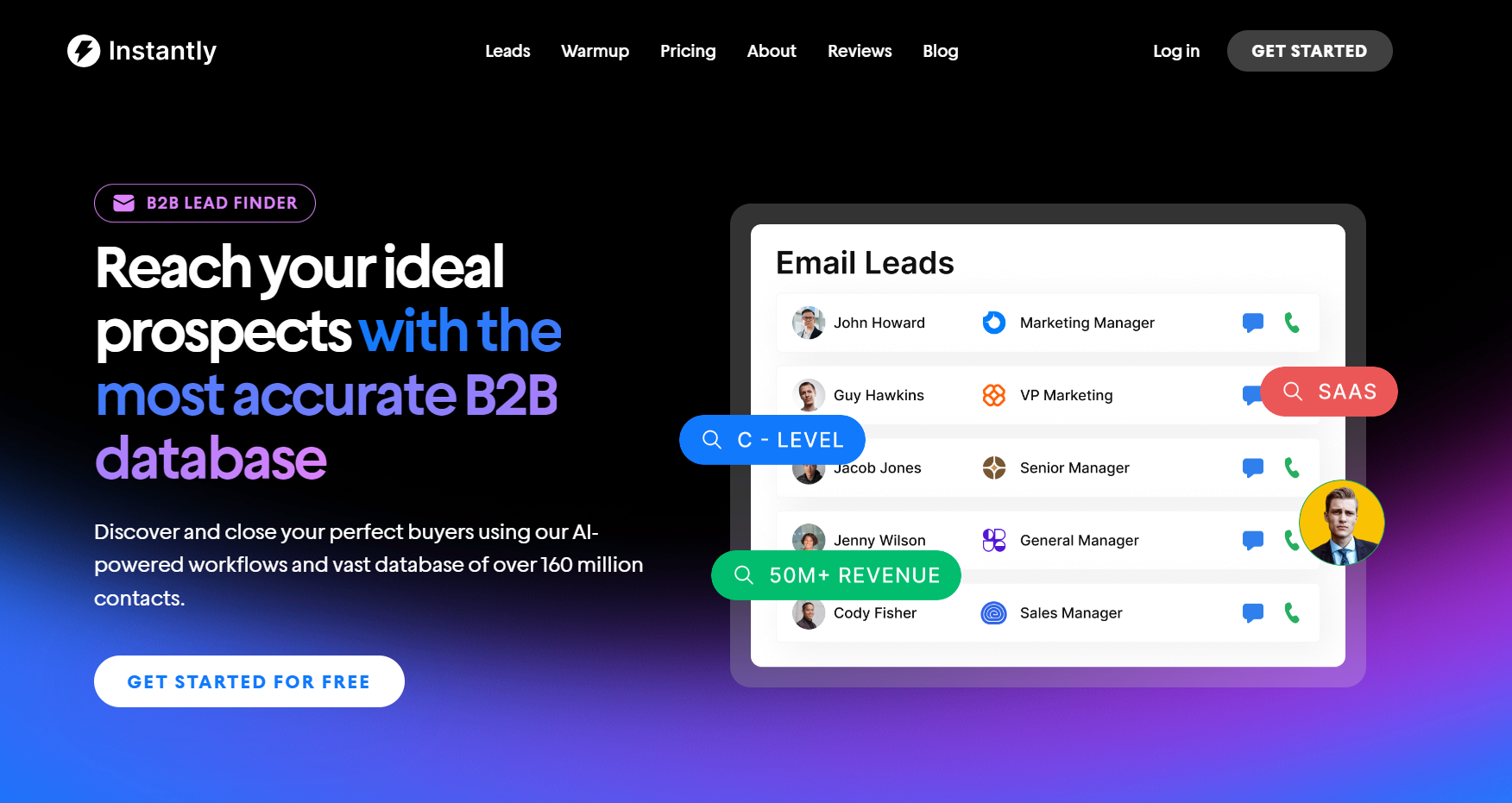Company contact lists are like gold dust for email marketers and sales professionals—like keys to a vault of potential customers. Acquiring them will not only improve the effectiveness of your campaign but also expand your network.
Forging new relationships is at the heart of B2B but, building a comprehensive company contact list takes time. It’s a job worth doing. It’s also a job that has to be done correctly if you want to remain compliant and on the right side of the "email law."
In this article, we’ll share how you can overcome the challenges of compiling company contact lists, including where to go to source them. You’ll learn how to ethically access people’s data and information so that you can build personalized communication.
- Sourcing and compiling company contact lists that are robust and useful.
- Using individual email addresses rather than generic mailboxes.
- Integrating company contact lists into your email marketing strategy.
The Importance of Company Contact Lists
Company contact lists are a collection of opportunities. Each perspective mailbox is a chance to open a conversation, nurture a relationship, and create a conversion. In the right hands, these lists supercharge your outreach.

The Right Contacts for the Right Relationships
Focus on quality over quantity. A digital Rolodex full of contacts may seem like something to brag about. But it's only impressive if those people want to hear from you and are engaged.
The ideal list should be full of contacts who have consented to hear from you. They should also gain value from the content that you send. In an ideal world, each contact will also be a decision-maker. If they’re not, don’t worry too much. As long as they’re engaged, it means that your industry authority will continue to grow through enhanced brand awareness.
Sales Outreach Opportunities
Targeted outreach through personalized email is achievable thanks to a carefully curated list. When you can tailor content that resonates with the user and delivers value, your chances of conversion soar. Conversion doesn’t necessarily mean a sale. It could be as simple as getting the recipient to engage with a new blog post or book a free trial.
Where to Find Company Contact Lists
These contacts don’t appear from thin air. You have to search for them before you can add them to your list. The question is, where? Knowing how to find email addresses efficiently is a skill. Thankfully, it’s one that you can learn.
Online Directories and B2B Databases
Plenty of tools have been created specifically for finding contact information. These vast databases allow you to search and discover potential contacts for your list. You can search by name, company, or even web domain.

These databases tend to give access via a monthly subscription. You could use a standalone tool such as Instantly’s B2B lead finder, or you could access a Chrome extension from another provider. The benefit of using a tool like Instantly’s is that you have access to a vast database. It’s also an integral part of the email marketing tool. That means any emails you find will be verified automatically, and you’ll only ever pay for legitimate, verified leads.
LinkedIn also classifies itself as an online directory if you access it using Sales Navigator. This is LinkedIn’s own version of a B2B database. It uses information that account holders put onto their profiles and gives subscribers access to it.
LeadGibbon or ContactOut are good choices for Chrome users who want access to email finders wherever they head on the web.
Trade Shows and Networking
Networking is just as powerful as ever. People like doing business with people they have met before. If you’re in a position to attend trade shows or networking events, you’ll quickly find that your company contact lists grow rapidly.
Even better, if you save that contact into a central customer relationship management (CRM) tool, you can record the interaction. You can then pay credence to it when you compose a tailored outreach email. This kind of personalization is a significant step above simply using their name or company when reaching out.
Public Records and News Releases
If the specific company you’re targeting has a public and media profile, you might get somewhere by following news outlets that cover them. Businesses often include email addresses as a means of contact. The news doesn’t even have to be recent. You could scour older articles, too. Just verify the email address to ensure the person in question still works there.
Social Media
Social media is a great place to find company contact emails. Spend time in industry-appropriate groups. You'll often find people sharing email addresses. It might not deliver the best results, but if you get specific with your targeting, it’s absolutely possible to find individual emails this way.
Manual Searches
The least efficient method, but also one of the most accurate, is to search for contact details manually. Finding targets' work bio pages or information on the company website is a surefire way of getting the right email addresses. However, it does take time and effort.
Integrating Company Contact Lists into Email Marketing

Creating the list is one thing. Using it properly for the benefit of your business is a whole other task entirely. Implemented correctly, it can be a game-changer for your outreach. Turbocharging it to a level you may have previously thought was unachievable.
Building the List Properly
Your email list needs to comply with legal requirements. That means consent. Contacts have to agree to receive communications from you. Immediately, the question is, how can you get consent from someone who doesn’t know you? How is it possible to cold email someone who hasn’t given you consent?
GDPR and CAN-SPAM don’t ban cold emailing. They state that the recipient has given their consent to be mailed for marketing purposes. Otherwise, you need to have legitimate reasons for outreach.
You should also ensure that any signup forms on your website allow subscribers to opt out of communication. You also need a clear way for someone to unsubscribe from further communication from you should they want to.
Segment the List
It’s tempting to take your whole list and send them the same email campaign. While it is low effort, you’re not maximizing the opportunity you’ve worked hard to create.
When you use email list segmentation, you can get more specific with your message. That means your content resonates more, and your conversion rates will rise. Segmentation could be through several features, such as demographics, location, and interests.
This doesn’t mean you have to create entirely different campaigns for each segment. It means you can tailor the content to fit their needs better. That could be an alteration to the call-to-action or subject lines that speak more to their interests.
Include Personalization
People like to receive communication that speaks to them directly. Receiving a generic marketing email makes you feel like you’re just another contact on a list. If, as marketers, we can alleviate that feeling, we’re onto a winner.
Personalization goes further than including their name. Think about the segment they’re part of and personalize the email to their needs. You might even offer them specific promotions or discounts based on their purchase history or interests.
Maintain Your Company Contact Lists
Email lists evolve over time. People move jobs, get married, change their names, or leave companies. That means their email is no longer a valid addition to your list. The question is, how can you know that has been the case?
The answer lies in your email marketing metrics. Look at your engagement rates and bounce rates. Open rate will show which recipients are opening your emails. If they’re opening your emails, then the email must still be valid. Bounce rate refers to deliverability. The email will be classified as a bounce if it isn't delivered. These addresses should be removed from your list.
Company Contact List Best Practices
Adhere to these best practices, and your company contact list will be in the best possible shape. This will also ensure that you’re using it as effectively as possible.
- Regularly validate email addresses: Don’t just validate email addresses when you first obtain them. Put them through the validation process regularly to keep your email list clean. Use an email verification tool to automate the task.
- Use Sender Policy Framework (SPF) and DomainKeys Identified Mail (DKIM): It's a technical process, but implementing SPF and DKIM into your email process at the DNS level helps prevent spam. It also dramatically improves deliverability.
- Never purchase a list: Purchasing a list might seem like a quick way to skip a lot of work, but doing so is a fool’s game. You’ll end up with negligible engagement rates and a whole list of people with little chance of ever converting. Plus, chances are they aren’t even real mailboxes.
- Be open about your privacy policies: Privacy policies help you to look legitimate and remain compliant. Don’t hide them. Wear them as a badge of honor.
- Use a professional email marketing tool: Manual outreach will yield minimal results. If you’re serious about using your company contact lists effectively, invest in email marketing software.
- Consider tracking pixels: Have you ever wondered how to see if someone has read your email? Pixel tracking is the way forward. Just be sure to be open and transparent with your recipients.
- Offer value in every email: Don’t send emails for the sake of it. There has to be something of value to the recipient. This ensures that the relationship is one of mutual gain. Maintaining this balance makes it far more comfortable for everyone involved.
Key Takeaways
Building, maintaining, and using company contact lists is no small undertaking. The effort is worth the payoff. Once you send email campaigns to engaged users, conversion rates will increase quickly. Ensure that you curate your list ethically and compliantly, and soon, you’ll be nurturing worthy relationships.
- Be strategic in your acquisition of new contacts to add to your list.
- Implement a continuous improvement policy for your lists.
- Above all, ensure you respect the wishes of those individuals added.
Managing company contact lists isn’t a job for a spreadsheet. It certainly isn’t a job for a pad of paper. You need a quality email list management tool with built-in campaign management and AI-powered automation. That’s Instantly. Outreach subscriptions start from just $37 a month, but you can start today for $0 when you sign up for a free trial.




